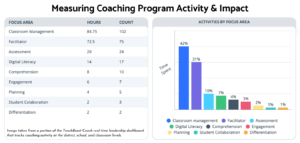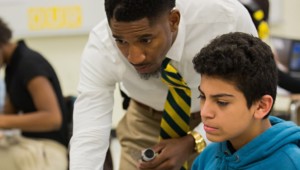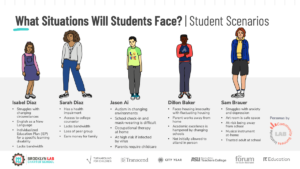Would Alabama’s Football Coach Nick Saban Do This?

“Would Alabama’s Football Coach Nick Saban Do This?” by Greg Green was first seen on The Flip Institute blog. Greg Green is the principal of Clintondale High School in Clinton Township, MI, which is also known as The Flipped High School.
We all know that something in our educational processes is not right. Our businesses talk about how our graduates lack skills, our government talks about how we are falling behind as a nation, our neighbor talks about how they can’t find a job and our schools talk about how frustrated they are. Like the scene in the movie Moneyball “blah, blah, blah, blah, blah.” All talk aside, what is the fix? We can even debate it, yet not many will argue that something needs to change. Once we starting fixing our nation’s education our neighborhoods can begin to regain their confidence, our communities can start to feel like an actual community and our local economies may just start to pick up.
Examining Our Current Teaching Model
Let us look at our current educational model we now use. A teacher or expert in front of a room of 30 participants reviews a certain concept with their pupils, does a couple of “guided” practice exercises, some independent work, check’s their pupil’s basic understanding and then sends them home to practice on their own. Sound familiar for every high school teacher and student?
Let’s put Alabama’s Nick Saban in the same type of scenario. Coach Saban draws out the playbook on a big beautiful white board for 40 minutes, he does a guided practice exercise for five minutes, some independent work for five minutes, asks his players a question while leaving out the door and calls it a day. During his class session his players attended to every word. They did the quick exercise with such enthusiasm and worked quietly and left the room orderly fashion. He is confident, because his players seem focused and his old methods have worked before. Great right? His player’s go on the field on Saturday in front of 80,000 fans and plays Auburn and his players look like a bunch of confused misfit toys. After the game, he is just down right angry and says that his players did not execute the plan. He knew he had a great practice, everyone was on target yet the results were awful. University Alabama’s alumni and their president is calling for his head because this is his football team’s third straight loss to their most hated rival. This sounds all too familiar to a lot schools, students, teachers, administrators and institutions.
What is the Problem?
What is the problem? First, lets check at the amount of time that players we actually actively involved in the learning process.
- 40 minute lecture – coach active
- 5 minute guided practice – player active
- 5 minute independent work – player active
- 5 minutes for checking for understanding and closure – player active
- Scoreboard Coach 40 and Players 15
In our example, did his players have extended time to ask questions? Did he allow for them to run lots of plays and examples while giving them instant feedback along the way? Did he extend his learning session so that older, more experienced players could offer their help so to build better relationships, leadership and personalize their own learning? Did they have an extra assistant to help them outside of practice or set up a mock practice facility or scrimmage for them? The answer is no. There is not one effective football college football coach in America who would run his program like the first example however, this is how we run many of our learning environments in America today and we then wonder what is wrong.
24 Hours
Everyone has one thing in common, twenty-four hours a day. It is what you do in those twenty-four hours that will decide someone’s success and failure. That is exactly what a teacher, a school and a business has in each one of their own learning environments. Do you stand and deliver or guide, mentor, coach, consult with the time that you have?
I am not a proponent that we should model what coaches do on a day-to-day basis however, we would be foolish not to look at the successful teaching and learning practices that they have implemented. Believe me, if their model for teaching and learning did not work, with today’s coaching pressures, they would be trying desperately to figure out another way. What coaches have realized is that they need to maximize the amount of time that they spend with their players so reversing or flipping their instructional model to maximize the time and feedback makes it a no brainer. They also have realized that by flipping they also take total control of their learning environment. Athletic competition has forced coaches to realize that the only way that their players are going to “get it” is if they offer everything for their athletes, facilities, study groups, practice schedules, time, mentors, simulations, scrimmages, experts, technology, special equipment with their immediate and direct expert feedback so that they are successful. They are leaving nothing for chance. Coaches know their systems inside and out system, now they need their players to own it and know it. By the way, they don’t have uncle Tim, who never played football whose is an unemployed alcoholic, going over plays for homework for their big game against Auburn!
Who Owns It?
Why do you think in college athletes come back to see the coaches who screamed and yelled at them for four years? Believe me, not because they enjoyed someone blistering them. They return because the coach was able to offer them not only a great learning environment, but even more, a sense of ownership. Within four years, they had given their older players an opportunity to teach and mentor the new players. The team leaders held meetings so everyone can learn from their mistakes, built and strengthen their relationships with their teammates and coaches by constantly communicating and working through the system. Through that active learning and teaching process, they are finally owning it! Those older players cry after a heartbreaking loss, not because they lost suddenly, but because they have so much invested. Next time, take note of the new players and how they leisurely jog back into the locker room because they have been passively taken a backseat and have yet built their own sense of ownership.
Yet, in our first example of Coach Saban’s practice isn’t that how we teach math, science, social studies, English and so on. It sure makes me wonder what we are thinking. We want all students to take ownership of their learning, receive timely feedback, use research based practices and give back to the community however, I challenge that our model for teaching and learning is not set up for that. By making a conscious decision to flip our classrooms, we finally have the time and opportunity give each student the necessary resources, experts, practice and feedback for our students to become classroom leaders. Flipping is not about videos. It is about structure, research, quality resources, practice, feedback, support and student ownership. I learned a lot from my coaches, I just didn’t realize how much. Thanks coach!!







Robert Clegg
Funny, we all have our blind spots and are entrenched in ways of doing things - I actually created the first interactive playbooks back in 1987. University of Michigan was my first client in 1989 (the Championship year). In 1991 I created the first quarterback training simulation for the Minnesota Vikings. I was showing coaches that their players could accelerate their learning by going through an interactive playbook. I could customize the learning for each player, create detailed reports of individual weaknesses, let the coaches know what to emphasize the next day, and provide data they couldn't get by any other means (I could track video responses spatially on the field down to 1/30th of a second and tell you exactly when and where a player was making right or wrong decisions). I could tell you who was reacting the fastest mentally or that your star player was making the wrong reads but making up for it physically.
Do you think the coaching world was ready for this new innovation? Do you think any of them were ready to admit that their process could be made more efficient OFF the field? Do you think there were gate keepers in the video room or computer room that didn't want anyone from the outside showing them up or wouldn't pass it up the line because they had never heard of computer aided instruction (the word "interactive" was just coming into vogue then).
I stopped in at Notre Dame to meet with one of the top defensive coordinators in the country at the time. I showed him an animated interactive playbook that could test his players in real time making post snap and mid-play reads. Do you know what he said? ... "Can you print that?" (meaning my graphics on the Mac were so clear and crisp he wanted to just make his playbook look better).
Or what about the business model around the NFL and major collegiate programs. Do you think they had money for this new technology? You'd be surprised how many NFL teams are operating extremely tightly and don't have a mandate to win at all costs. Or what about the entrenched attitude of teams that expect any innovation to be given them for free expecting you to monetize it with other schools and kids.
I bet you $1 Alabama doesn't have interactive playbooks today. I bet they don't use interactive video running players through hundreds of mental reps before getting on the field to use precious coaching time.
With all the coaching changes at Michigan, don't you think they'd want an interactive system to get players up to speed 20-50% faster?
If one of the most competitive and highly lucrative industries can't grasp new educational tools when education and instruction is at the heart of what they do, how do we expect schools to?
ps - years later (2002) I've gone on to design the first video games and multiplayer network to teach algebra. Full university research studies show 2-3 grade level improvements (2008). How fast do you think that's getting adopted? How many vc's are figuring out business models to make this work?
Best,
-Robert
... Go Blue!